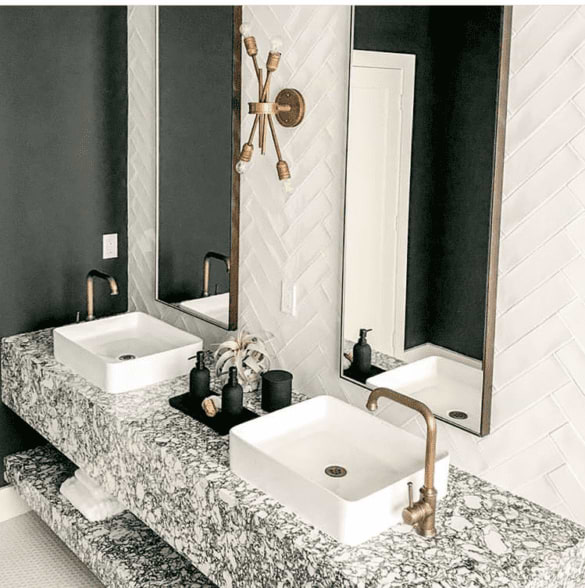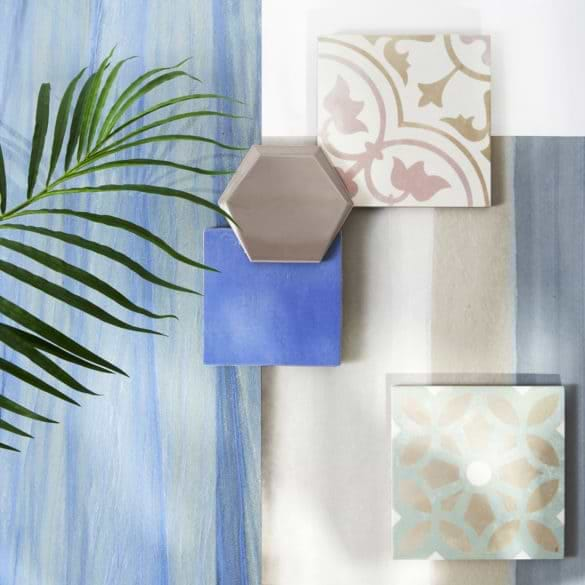One of the main design focal points of these areas is the backsplash. So, if you’re in the process of deciding on tile to use for a redesign or building a new kitchen or bathroom completely, there’s a few things you’ll want to keep in mind. Today, we cover all things backsplash so you leave here question-free.
What Is A Backsplash?
Backsplashes, for those who aren’t familiar, consist of the areas between your counters and cabinetry which fall victim to toothpaste splashes and kitchen catastrophes– ahem, marinara sauce, looking at you.

This key area works to define and defend your design in many ways. Here’s a few:
- Accent Away. The backsplash is a classic accent piece. It is one section of design that can make a splash, pun intended, on the overall feel of your space. If you want to create a bit of quirk, you can do that with your choice of backsplash tile. The design possibilities are nearly endless.
- Warm Things Up. Another reason that backsplash tile is so predominate in design stems from the fact it can do wonders to a cooler design. If you have a cooler toned design, bringing in a backsplash with warm undertones can help infuse a sense of welcoming.
- Tie It All Together. The third way a backsplash can do wonders for your design is its ability to tie things together. If you have cabinetry that is on the busier side, using a solid subway tile can help tone it down and make the look flow better. On the other hand, if you have more simplistic design elements, adding a patterned backsplash tile can completely liven the space up.
- Keeps Things Tidy. Instead of worrying about pesky staining due to spills, backsplashes protect your walls and provide an easy way to clean up after yourself.
When is the right time to choose backsplash tile?

The backsplash should be one of the final elements that is added to your design. We recommend scoping out your entire project first, and then finalizing the design with a backsplash of choice. The reason behind this is simple: It lets you see how a tile will work within a complete look. It helps alleviate design woes later on, because you are better able to match finishes and colors.
Choose A Material
There are several types of tile that work extremely well for a backsplash. The top 3 we’d recommend are porcelain, ceramic, and natural stone. Porcelain is a very durable, easy-to-maintain option. It won’t stain easily, and can withstand some wear and tear. Ceramic is a traditional style that like porcelain is non-porous so upkeep is minimal. The final option is natural stone. Another classic, that is strong, but due to the earthy nature of the material is porous.
So when it comes to using say, marble for a backsplash, maintenance is key. We always advise to seal and reseal to get the most life out of it, and keep it stain-free.
Choose Backsplash Tile Patterns
One of the more exciting things about tile is the ability to customize the lay pattern. You can create movement with herringbone or chevron patterns, which are achieved by simply rearranging the way you place the tile on the wall. Or, you create more intricate looks like a French mosaic with glass tiles.
What should the height for the backsplash be?
The final question that may come up is how much backsplash to cover. For some, covering wall-to-ceiling is a great way to add depth to a smaller space, but could be out of budget. For others, with a tighter budget, covering just the area above the counter is ideal.
Want even more inspiration? Check out our Top 5 Backsplash Designs post >>
Common Backsplash Mistakes
There are several, common backsplash mistakes to avoid. Read through the following carefully, since you’re a smart person, and we know you’re above making these mistakes.
Buying without Sampling. One of the most important steps in considering anything tile-related is sampling. It lets you see and feel the material in person, and decide how it will fit into your home. Here at TileBar we always offer 5 samples for $5.
Trendy Over Timeless. We are personal fans of trends, we wrote a whole article on them after all; however, in the case of backsplashes it is ideal to keep your sights realistic. Tile is an investment and what you settle for should be something you want in your home 5, 10 years from now.
Ignoring Full Design Plan. As mentioned earlier, but truly driving the point home now, we can’t stress enough the importance of keeping your entire design in focus throughout the process. This will keep you from having costly mistakes or regrets on your hands later on.
Ignoring Appliances. Appliances are another area that should be considered thoroughly before proceeding with the backsplash. It’s important to decide on a design scheme. If you choose more traditional appliances, it would look completely out of place to pick a more industrial-looking or metallic tile. You also wouldn’t want to choose a rustic, wooden oven range hood then match it with a luxury waterjet (most times) since it would send a confusing message.
Not Creating Cohesiveness. Since the backsplash will be the final part of the design, it’s important to get all the elements for the rest of the kitchen or bathroom together first. Figure out the type of countertops that you want – natural stone with a veining that contrasts or solid wood? From here, choose the cabinetry, since you don’t want to risk these two items fighting against one another for attention, be careful. If your countertops are going to be more intricate then the cabinetry can be more simple. If you go with a light colored, natural stone countertop, bringing in warmth with cabinetry is a good move.
Not Considering The Floor. For instance, if you choose wood flooring, you’ll need to make sure it pairs well with the counters, the cabinetry, and the backsplash. If you opt for tile flooring, then you need to make sure it will pair well with whichever tile you end up choosing for backsplash. The last thing you need is similar tones working against one another!
There you have it, the complete guide to fool-proof backsplash tile design for your home. For even more inspiration, check out all of the backsplash tiles available on TileBar:

